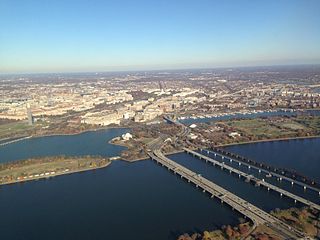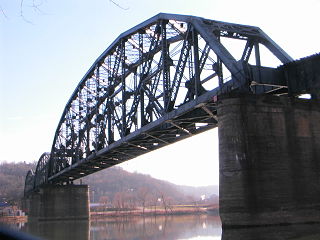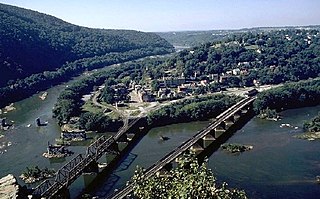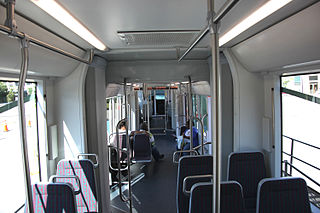
The 14th Street bridges refers to the three bridges near each other that cross the Potomac River, connecting Arlington, Virginia and Washington, D.C. Sometimes the two nearby rail bridges are included as part of the 14th Street bridge complex. A major gateway for automotive, bicycle and rail traffic, the bridge complex is named for 14th Street, which feeds automotive traffic into it on the D.C. end.

Minnesota Avenue is an island-platformed Washington Metro station in the Central Northeast/Mahaning Heights neighborhood of Northeast Washington, D.C., United States. The station was opened on November 20, 1978, and is operated by the Washington Metropolitan Area Transit Authority (WMATA). Providing service for the Orange Line, the station is the last station East Of The River, and the last above ground station for westbound trains until East Falls Church; west of the station, trains cross over the Anacostia River, then curve over RFK Stadium parking lots before descending underground.

The Whitney Young Memorial Bridge is a bridge that carries East Capitol Street across the Anacostia River in Washington, D.C. in the United States. Finished in 1955, it was originally called the East Capitol Street Bridge. It was renamed for civil rights activist Whitney Young in early 1974. The bridge is 1,800 feet (550 m) long, its six lanes are 82 feet (25 m) wide, and it has 15 spans resting on 14 piers.

The Louisville and Indiana Railroad is a Class III railroad that operates freight service between Indianapolis, Indiana and Louisville, Kentucky, with a major yard and maintenance shop in Jeffersonville, Indiana. It is owned by Anacostia Rail Holdings.

The Arthur Kill Vertical Lift Railroad Bridge is a rail vertical-lift bridge connecting Elizabethport, New Jersey and the Howland Hook Marine Terminal on Staten Island, New York, United States. The bridge was built by the Baltimore and Ohio Railroad in 1959 to replace the Arthur Kill Bridge, a swing bridge opened in 1890. It contains a single track that is used mainly to carry garbage out of New York City, as well as to transport freight to destinations in western Staten Island. The bridge parallels the Goethals Bridge, which carries Interstate 278. It has the longest lift span of any vertical-lift bridge in the world, with two 215-foot (66 m) towers and a 558-foot (170 m) truss span that allows a 500-foot (152 m) channel. It clears mean high water by 31 feet (9.45 m) when closed and 135 feet (41 m) when lifted.

The Glenwood B&O Railroad Bridge is a truss bridge in Pittsburgh, Pennsylvania, which carries Allegheny Valley Railroad's W&P Subdivision over the Monongahela River.

The Thomas Viaduct spans the Patapsco River and Patapsco Valley between Relay, Maryland and Elkridge, Maryland, USA. It was commissioned by the Baltimore and Ohio Railroad (B&O); built between July 4, 1833, and July 4, 1835; and named for Philip E. Thomas, the company's first president. It remains the world's oldest multiple arched stone railroad bridge.

The Metropolitan Subdivision is a railroad line owned and operated by CSX Transportation in the District of Columbia and the U.S. state of Maryland. The line runs from Washington, D.C., northwest to Weverton, Maryland, along the former Metropolitan Branch of the Baltimore and Ohio Railroad.

The Amtrak Railroad Anacostia Bridge is a railway bridge that crosses the Anacostia River in Washington, D.C. It carries Amtrak's Northeast Corridor and MARC's Penn Line passenger rail traffic. The bridge was damaged by the 1933 Chesapeake–Potomac hurricane, causing the famous "Crescent Limited wreck".

The B & O Railroad Potomac River Crossing is a 15-acre (6.1 ha) historic site where a set of railroad bridges, originally built by the Baltimore and Ohio Railroad, span the Potomac River between Sandy Hook, Maryland, and Harpers Ferry, West Virginia, in the United States. The site was added to the National Register of Historic Places on February 14, 1978 for its significance in commerce, engineering, industry, invention, and transportation.
The Landover Subdivision is a railroad line owned and operated by CSX Transportation. It runs from the Anacostia section of Washington, D.C., to Landover, Maryland, serving as a freight train bypass of Washington Union Station.
The RF&P Subdivision is a railroad line owned and operated by CSX Transportation. It runs from Washington, D.C., to Richmond, Virginia, over lines previously owned by the Pennsylvania Railroad and the Richmond, Fredericksburg and Potomac Railroad. The line's name pays homage to that railroad, which was a predecessor to the CSX.

The Alexandria Extension is a short rail line in Washington, D.C. and Prince George's County, Maryland. Its northern portion connects the Capital Subdivision to the RF&P Subdivision, allowing freight trains to avoid Downtown Washington. Its southern portion, the Shepherd Industrial Spur, extends south to Shepherds Landing, directly across the Potomac River from Alexandria, Virginia; service on this portion ended in 2001.

From the start of railroading in America through the first half of the 20th century, New York City and Long Island were major areas for rail freight transportation. However, their relative isolation from the mainland United States has always posed problems for rail traffic. Numerous factors over the late 20th century have caused further declines in freight rail traffic. Efforts to reverse this trend are ongoing, but have been met with limited success.

Little Ferry Yard is a railyard and intermodal terminal in the Port of New York and New Jersey served by the CSX River Subdivision (CSXT), New York, Susquehanna and Western Railway (NYSW), Norfolk Southern Railway and Conrail Shared Assets Operations (CRCX).

Long Bridge is the common name used for a series of three bridges connecting Washington, D.C. to Arlington, Virginia over the Potomac River. The first was built in 1808 for foot, horse and stagecoach traffic. Bridges in the vicinity were repaired and replaced several times in the 19th century. The current bridge was built in 1904 and substantially modified in 1942 and has only been used for railroad traffic. It is owned by CSX Transportation and is used by CSX freight trains, Amtrak intercity trains, and Virginia Railway Express commuter trains. Norfolk Southern Railway has trackage rights on the bridge but does not exercise those rights. In 2019 Virginia announced that it would help fund and build a new rail bridge parallel to the existing one to double its capacity, following the plans that have been studied by the District Department of Transportation (DDOT) and Federal Railroad Administration (FRA) since 2011.

The Anacostia Line is a partially constructed line of the DC Streetcar, never put into service, intended to connect the Anacostia neighborhood with Joint Base Anacostia–Bolling. Construction occurred in 2009 and 2010, but was terminated before the line was complete.
















